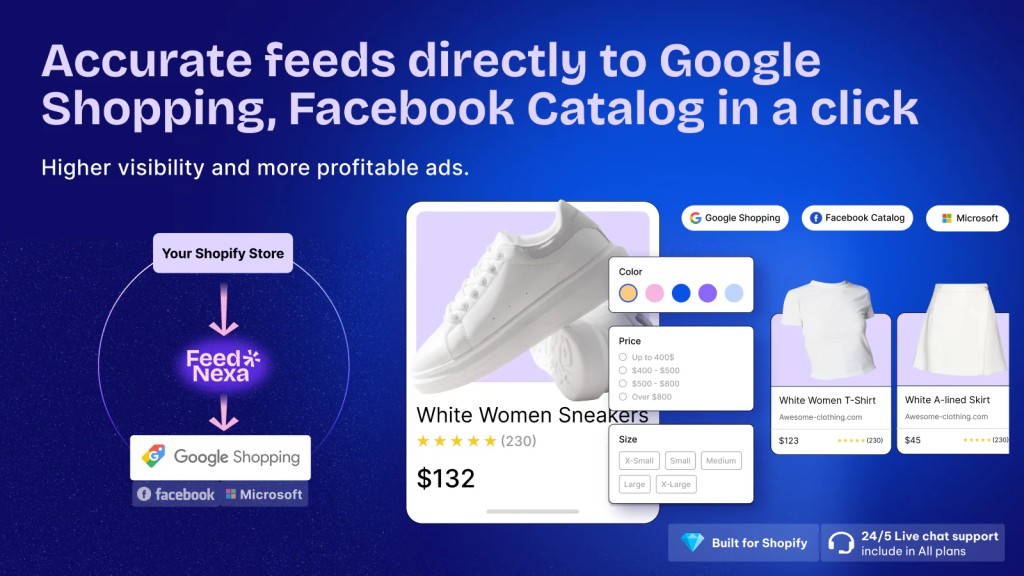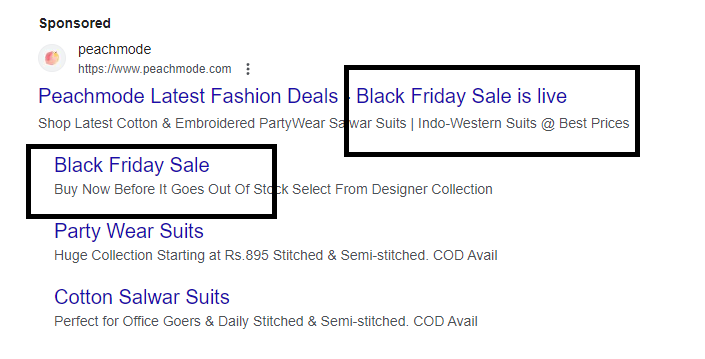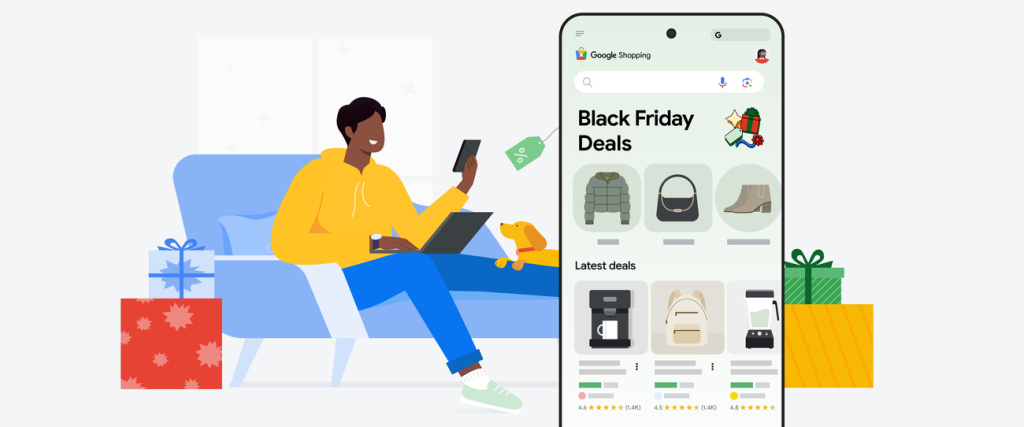Google Shopping Black Friday Secrets: What Top Stores Know

According to Think with Google, 34% of U.S. consumers said they had already started their holiday shopping in July 2024. That means if your Google Shopping Black Friday campaigns aren’t optimized early, you risk losing visibility right when buying intent peaks. With the right strategy, you can stay ahead of the rush!
| What you’ll learn in this article: ● Top Google Shopping Black Friday Strategies ● Benefits of Choosing the Right Strategy ● Which Strategy is Right for You? |
Top Google Shopping Black Friday Strategies
These Google Shopping strategies come from campaigns tested across multiple Black Fridays. Each tip focuses on what truly works when competition spikes and shoppers are ready to buy.
1. Optimize Your Product Feed Before the Rush
One misplaced attribute or outdated image can cost you thousands in lost impressions during Black Friday. Your product feed is the single source Google relies on to understand what you sell, so accuracy and freshness are everything.
Audit your feed early to ensure all titles, descriptions, and images match your promotions. Include key attributes like GTIN, brand, and availability. The more relevant and data-rich your feed, the higher your chance of showing up when shoppers are searching for “Black Friday deals near me” or “discounted [your product type].”
2. Segment Products with Custom Labels for Smarter Bidding
During Black Friday, not every product deserves the same budget. Some SKUs bring in higher margins or convert better at lower CPCs. Custom labels let you divide products into performance groups like “high margin,” “clearance,” or “top sellers”, so you can bid strategically instead of guessing.
This segmentation gives you control when competition spikes. You’ll know exactly where to increase bids and when to pull back, keeping your ad spend efficient without missing high-value clicks.
If you want to skip the manual work, FeedNexa lets you generate custom labels automatically using flexible rules like margin, inventory, or category, making your campaign management faster and far more accurate.

3. Combine Performance Max with Manual Shopping Control
Automation can scale fast, but it shouldn’t replace control. Performance Max campaigns help your store appear across Search, Display, YouTube, and Discovery. However, pairing it with Standard Shopping campaigns lets you manually fine-tune bids for your top-performing products.
That balance of automation and control ensures your high-intent shoppers always see the right product at the right moment. Instead of flooding Google with generic ads, you stay focused on profitable conversions.
4. Use Merchant Promotions to Win the Click War
Everyone discounts on Black Friday, but not everyone gets noticed. Merchant Promotions give your listings that extra push by displaying special offers right under your product title, making your ad stand out instantly.
Set up clear promotions like “Buy 1 Get 1,” “20% off Today Only,” or “Free Shipping.” These small visual triggers drive urgency and help you compete even if your prices match your competitors’.

5. Keep Your Google Shopping Feed Optimized in Real Time
Black Friday chaos often hits where merchants least expect it: data mismatches, feed rejections, or outdated pricing across channels. When Google flags your products as “disapproved,” you lose visibility instantly. That’s where FeedNexa becomes a game-changer.
Feednexa helps you optimize Google Shopping Ads with accurate, data-rich, multi-channel product feeds.
Key benefits for Google Shopping Black Friday:
- Syncs accurate product data with required fields like GTIN, MPN, and availability.
- Prevents feed disapprovals and errors during peak Black Friday traffic.
- Bulk update pricing and inventory to match live promotions.
- Keeps your feed auto-synced with real-time discounts and stock levels.
- Boosts rankings with fully optimized, Google-approved data quality.

Google emphasizes that even small errors in GTIN, pricing, or availability can lead to disapprovals and lower ad performance. Using a feed tool that ensures data accuracy helps prevent those costly interruptions.
6. Monitor Data and Adjust Fast During the Sale
Black Friday performance can change every hour. Products that tanked yesterday might explode today. Successful advertisers track metrics in real time: CTR, ROAS, and conversion volume, and react quickly.
Don’t hesitate to reallocate the budget mid-sale. Pause low-performing products and push more spend toward trending ones. Small adjustments can mean huge differences in profit during these fast-moving campaigns.
7. Tap Into Seasonal Keywords Shoppers Actually Use
Every brand wants to rank for “Black Friday deals.” The problem? Everyone is ranking for it.
If your titles and descriptions don’t match how shoppers search right now, your products disappear in the noise. Instead of broad keywords, use intent-driven phrases like “best Black Friday deals under $50” or “limited-time [product type] discount.”
People on Google Shopping aren’t casually browsing; they’re ready to buy. Updating your feed with seasonal keywords helps your ads show up right when their wallets are open.

8. Make Your Product Images Impossible to Ignore
You can have the best price in the world, but if your image looks dull, no one clicks. Black Friday results pages are packed with color, flash, and discount tags. A flat product photo simply won’t compete.
Go for bright, clean visuals that highlight your product’s value at a glance, maybe a lifestyle shot or a bold “Black Friday Deal” overlay. You’re not just selling the item; you’re selling the feeling that this deal can’t be missed.
9. Adjust Bids Based on When and Where People Shop
Ever noticed how conversions spike late at night or drop during work hours? That’s not random, it’s behavior. During Black Friday week, people compare prices on their phones during the day and complete the purchase later on a desktop.
Use your data to schedule bids around peak times and adjust by device. Don’t burn your budget showing ads when your customers aren’t shopping. The smarter your timing, the cheaper your clicks and the better your returns.
10. Bring Back Shoppers Who Left Without Buying
Here’s the truth: most people won’t buy the first time they see your ad, even if your offer’s great. They’ll open five tabs, get distracted, or wait to compare deals. That’s why remarketing is your best friend during Black Friday.
Target people who clicked on your products but didn’t purchase. Show them the exact item again, maybe with a small extra incentive like “still in stock” or “extra 10% off today only.” A well-timed reminder often converts the window-shoppers you thought were gone for good.
To make your remarketing even more powerful, take advantage of Google’s AI Mode with Virtual Try-On. This feature helps shoppers visualize how products look on real people, building confidence to complete their purchase. When buyers can see themselves using the product, your remarketing ads feel more personal, and far more convincing.

Benefits of Choosing the Right Strategy
Black Friday competition on Google Shopping is intense, with brands racing for visibility and clicks. The right strategy keeps your ads profitable, helping you reach high-intent shoppers without overspending.
Here’s what the right Google Shopping strategy can bring you this Black Friday:
- Higher ROAS/ROI and smarter spending: Strategic bidding and segmentation ensure your budget focuses on high-intent searches that actually convert, not just clicks.
- Better product visibility: Optimized feeds, dynamic titles, and clear images improve how Google ranks and displays your products in Shopping results.
- Improved CTRs and conversions: Reaching shoppers ready to buy means your ads earn more clicks and sales during the shortest buying window of the year.
- Data-driven decisions: The right setup lets you track which items, devices, and demographics perform best, guiding future Black Friday campaigns.
- Brand credibility and trust: When your listings look polished and relevant, shoppers perceive your store as more reliable, which helps win them over even at premium prices.

Which Strategy is Right for You?
There’s no one-size-fits-all approach to Google Shopping on Black Friday. The right strategy depends on your goals, budget, and how complex your product catalog is.
If you’re running a smaller Shopify store, Smart Shopping or Performance Max campaigns help you reach more shoppers with minimal setup. But for merchants managing hundreds of SKUs, a Standard Shopping campaign with clear product segmentation gives you stronger control over bids, performance, and ad visibility.
For growing brands that want both flexibility and precision, FeedNexa helps simplify it all. It keeps your product feed clean, organized, and always up to date, allowing you to focus on refining your strategy and scaling your results during Black Friday.
Case Study: Stompa Boosts ROAS with Smart Google Shopping Strategy
Children’s furniture brand Stompa teamed up with Embryo to elevate their Black Friday 2024 performance. Their campaign featured a 30% discount on all beds, with a goal to drive higher efficiency and return on ad spend through both Google Search and Shopping campaigns.
Challenge
In previous years, Stompa’s ad performance plateaued. While they were achieving steady sales, their ROAS lagged behind category benchmarks, limiting the brand’s growth potential. They needed a campaign strategy that could both scale visibility and convert high-intent shoppers during the Black Friday rush, without inflating costs.
What They Did
The Embryo PPC team developed a data-led, multi-channel strategy that integrated Google Search and Shopping campaigns under one structure.
- Expanding keyword coverage for top-selling bed categories.
- Optimizing Shopping feeds with richer product data and seasonal titles.
- Extending the promotion period to capture early Black Friday traffic.
- Using real-time bid adjustments to push high-performing ads earlier in the week.
Results
The results far exceeded expectations:
- ROAS surged to 10.7x, more than double their 2023 figure.
- Revenue increased by 4% year-over-year, driven by improved conversion efficiency.
- Interestingly, performance peaked six days before Black Friday, when ROAS hit an incredible 17.4x, showing that early deal seekers were the most profitable segment.
Conclusion
Black Friday on Google Shopping isn’t just about lowering prices, it’s about timing, precision, and preparation. Shoppers start searching weeks before the sale even begins, comparing products and deciding where to buy. The brands that stand out are the ones that plan early, optimize their feeds, and stay agile when traffic peaks.
Keep your data clean, track performance in real time, and refine your bidding strategy as trends shift. When your feed, budget, and timing all align, your store doesn’t just join the Black Friday race, it leads it.